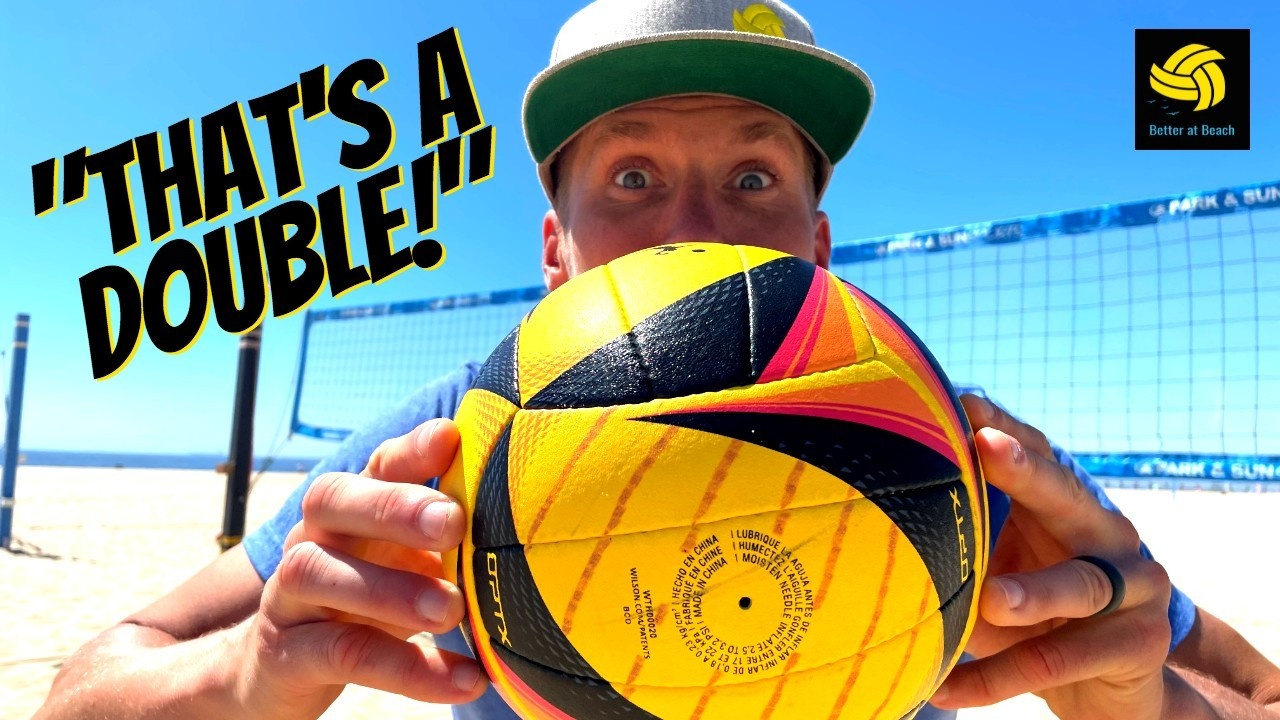
Volleyball Rules: What's legal (and what isn't) with hand setting
When it comes to the setting rules, there's still a lot of confusion in the beach volleyball community.
How do you know what’s legal – and what's not legal – with beach volleyball setting? Can anyone actually explain a double? Is there even a way to properly identify a lift?
And when, please, is a hit hard-driven enough to take open-handed?
We promise this will be the last article you'll ever need in order to become a handsetting rules expert.
If you'd like others to get up to speed on the topic as well, feel free to share this resource with your friends:
|
Everything You Need to Know About the Hand Set |
We've created the program to help you build clean hand sets from the ground up: Get progressive training taught by professional players and coaches, to develop flawless technique – that nobody can argue against!
Make sure to check out the 30-Day Setting Blueprint, as well as our full library of courses you can use to become a complete beach volleyball player →

Let's get into it. Let's, once and for all, take the mystery out of setting rules on the beach:
What Do The Beach Volleyball Setting Rules Allow? Overview
Here's the gist of what you can and can't do when setting on the beach. Click on the dots to read a short explanation of each part of the rules.
(We'll also cover each of them in more depth down below, including the FIVB's official wording):
Note
We are giving you the official rules from the top governing organizations.
In smaller tournaments, the directors often simplify the rules, or they are interpreted in a unique way to make it easier for players and refs. This can lead to confusion. We want to get you clear on the official, international rules.
Always check with your tournament director to see what exact rules they play by.
✅ You can use your hands on any ball – even on the first and third contact (over the net).
✅ You can set the ball sideways (laterally).
✅ You can have spin on a hand-set ball without it being a double.
✅ You can contact the ball low, between chest and chin height.
❌ You cannot push the ball out unevenly, with one hand more than the other.
❌ You cannot turn with the ball while holding it.
❌ You cannot visibly take the ball down with your arms.
What Is A Lift Fault, Exactly?
CATCH: the ball is caught and/or thrown; it does not rebound from the hit (FIVB Beach Volleyball Rules 2021-24, section 9.3.3)
A lift or catch during the setting motion in beach volleyball is determined by the referee according to whether the ball came to rest in the setter’s hands for too long:
“During the action of players setting overhand with fingers, the ball must be played with one quick motion.
There must not be any significant movement of the ball downwards whilst in the hands and the ball may not visibly come to rest in the player's hands.”
FIVB Official Refereeing Guidelines (2023), p. 6
Rules for lifting or catching the ball
- It is normal for the ball to come to rest for a split second during the setting contact
- The ball will go down during the set – simply because the hands and wrists are bent back by the contact. This is normal and fine and not considered a lift/catch
See: 2023 FIVB Refereeing Guidelines, p. 6: “Note: Technically in ALL hand setting actions the ball rests and also moves downward whilst in contact with the hands of the player. It is the quickness of this action that will determine if the "downwards motion" or the "length of the contact" is of visible significance, and consequently a fault.”
- If the ball comes to rest for an extended time, it is a lift
- If there is excessive downward motion – the ball is taken down a considerable distance by bending the arms – it is a lift
- If the ball is thrown out in a direction neither parallel nor perpendicular (but diagonal) to the shoulder axis, it is also a lift
These judgments are to be made by the referee, according to the prevailing, real-world technical standards in beach volleyball:
“There are various unique methods of setting and passing the ball in Beach Volleyball.
A referee must understand the nature of these ball contacts [..]
(the emphasis quite correctly with the catch or thrown ball is the duration of the contact)
and how technically correct or clean the contact was”
FIVB Official Refereeing Guidelines (2023), p. 6
How well do you know the beach volleyball rules? Take a quiz!
What Is A Double?
A double contact when setting in beach volleyball means the player took in or pushed the ball out unevenly with his hands.
“A referee must [concentrate] on how technically correct or clean the contact was
the emphasis with the double contact is that this is not indicated by the spin of the ball but by the fact that a clear fault – time difference between the two hands that contact the ball – has occurred and that this is visible for the referee.”
FIVB Official Refereeing Guidelines (2023), p. 6
Set direction and ‘squaring up’ - what’s legal and what isn’t?
Diagonal setting, or changing direction during the setting contact is fine if it's a swift, clean contact - i.e. not a double or lift.
Some changing of direction will be tolerated by the referee.
Can you overhand set the first ball?
There is no rule that generally forbids hand setting any ball, even when it’s the first contact.
Historically, playing the first ball with your hands has been judged harshly, especially in intermediate-level games. You either had to make it picture-perfect, or you couldn’t do it at all.
This is not backed by the official rules, though.
Recently more and more pro players – and some educated intermediate amateurs – have begun taking free balls (easy balls coming over the net) with their hands. It’s perfectly legal, but of course takes some skill and focus.
Just like with any hand set in beach volleyball, you can’t be sloppy when playing the first ball overhand.
Can you hand set the serve in beach volleyball?
Yes, you can – theoretically – hand set the serve. It has been done in professional tournaments without being called for a fault.
There is a big difference between serve receive rules in indoor versus in beach volleyball, though. The way many amateurs – who are not aware of the technical standards in beach play – receive the ball open-handed is certainly illegal.
Receiving a serve cleanly with a hand setting motion is very difficult and therefore risky – which is why it’s almost never attempted by any player, except in show formats like the King of the Court series.
It’s not recommended to try to receive serve with a setting motion in beach volleyball, because:
- It leads to a high number of double and lift faults
- Many players (and even referees) aren’t aware it’s actually legal to do – and will call you, even if your contact was clean
Learn how to SET today with the 30 Day Setting Blueprint!
Open hand defense - overhand setting rules when defending
As we’ve established, you are allowed to hand set any first ball in beach volleyball, as long as it’s as clean as any normal set (as defined by the above rules regarding lifts and doubles).
On defense, you have even more freedom to overhand pass the ball. If the attacker hits the ball right at you with power, you’re allowed to make a reaction play: You can use open hands to play the ball, and the contact can be longer than what’s legal in a regular hand set.
→ The rules are more loose when defending a ‘hard-driven’ attack:
"Extended contacts: In defensive action of a hard driven ball, the ball contact can be extended momentarily even if an overhand finger action is used."
FIVB Beach Volleyball Rules 2021-24, section 9.2.2.4
Now, what actually counts as a hard driven attack? There is so much controversy about this at the beach volleyball courts.
Here's what the official rules have to say about what does and doesn't constitute a hard driven ball. In short, it depends on the reaction time available to the player, as judged by the referee:
"A good indication of a hard driven attack is the time which the defensive player had to react to play the ball.
If the defensive player had time to make a decision or to react by changing their technique as to how to play the ball, it was probably not a hard driven ball."
FIVB Refereeing Guidelines (2023), section 10
*Note: Even if a ball was not hard-driven, it can sometimes be ruled as a legal reaction play:
If the defender is close to the net, and hitting a flat or downwards ball--even if the hit wasn't hard-driven, you have very little time to react.
In this case you can still take it in a setting motion, and you're even allowed to 'double' it.

↑ You can use both techniques when defending, as well as a double axe (two separate fists) or a tomahawk, where your hands are together.
If it is an easy, loopy ball, you have to play it cleanly without 'doubling' the ball.
Exception: If the ball inadvertently - not on purpose - hits your hand, and then immediately, hits and bumps off your head or body, it is not an illegal double contact. Even if the attack was not hard-driven!
If you're defending against a hard spike, you can also use the techniques shown and described above. And as stated: In this case it's legal to double contact the ball overhead (play it less than cleanly).
Can you set the ball over the net?
Yes, you can set over the net in beach volleyball.
- If you’re squared up (forwards or backwards) to where you’re setting, you can ALWAYS set over the net. You do not need to intend to set your partner – you can do an intentional attack using the hand setting motion. But you do need to be clearly squared up before contact.
- If you’re setting sideways over the net, it’s only legal if you were genuinely trying to set your partner – not as an attack. So in this case, the intent (as judged by the referee) is important. (Fault according to the official rules: 13.2.5 A player completes an attack-hit using an overhand pass which has a trajectory not perpendicular to the line of the shoulders. The exception is when the player is attempting to set to his or her teammate.)
"A player may complete an attack-hit using an overhand pass (which has a trajectory perpendicular to the line of the shoulders), either forwards or backwards.
Note: The referee should consider the line of the player’s shoulder at the initial stage of the contact with the ball. Players must establish their shoulder position before the contact is made."
FIVB Refereeing Guidelines (2023), section 4
Learn how to SET today with the 30 Day Setting Blueprint!
New Beach Volleyball Setting Rules in 2023?
In 2023, there haven’t been ‘new’ rules per se, but changes to how the existing rules are actually implemented.
It was a move back more towards the traditional interpretations of lifts and doubles in beach volleyball.
Players had gotten more and more loose with their execution over the years, and referees were allowing it -- the first principle was to 'keep the ball flying', to make the sport faster and more interesting to spectators.
"MESSAGE FOR 2022-2023:
The 2021-22 season has been pointed out by [..] the stricter assessment of setting using the overhand with fingers technique, aiming at reinstating the appropriate implementation of the Official BVB rules.
This was necessary due to the fact that following the Tokyo Olympics, there has been a noticeable trend in teams and referees respectively relaxing overhand setting techniques and the assessment criteria for this action."
FIVB Refereeing Guidelines (2023), section 1
After this change referees became more strict regarding lift calls especially. During the first few tournaments, this got some teams in trouble, and they’ve since had to become more careful not to hold the ball for too long.
In general, a low setting contact below the chin increases the risk of lifting the ball.
But – the best setters almost never get called for lifts or doubles.
Your best bet to almost never get called for lifts or doubles is to develop excellent hand setting technique. When you do hand setting right, you’re not taking the ball down much at all.
And you’re pushing it out evenly, so you almost never double.
There are some foundational details that help you have this clean technique: If you learn to do them properly, you’ll reduce the amount of discussions about your hand setting by 90%.
Better at Beach's 30-Day Setting Blueprint will help you develop those buttery smooth hands – that nobody can argue with.
2025 FIVB Rule Updates
A Game-Changing Decision for Volleyball
The international beach volleyball scene is experiencing a significant shift as FIVB introduces a groundbreaking change to beach volleyball setting rules. This modification promises to reshape how players approach the game, from recreational to professional beach volleyball levels. Let's dive into what this means for the sport and how it affects players at every level.
Understanding the New FIVB Rule
The FIVB has eliminated double contact calls during setting in international beach volleyball, provided the ball remains on the same side of the court. This revolutionary change means referees will only call doubles if there are two distinct, separate contacts with the ball. The days of debating spin rotation and minimal double contacts are over – at least in FIVB international competition.
Key Changes in Beach Volleyball Rules:
- No more double contact calls for minimal ball handling errors
- Double contact still applies for distinct, separate touches
- Rule applies differently when the ball crosses the net
- Currently in FIVB experimental phase for international beach volleyball
Impact Across Playing Levels
This change isn't just affecting the international beach volleyball scene – it's creating ripples throughout the volleyball community. From professional circuits to recreational leagues, players and coaches are reconsidering their approach to the game.
Professional Beach Volleyball Changes
The most immediate impact will be seen in jump setting at the professional level. Beach volleyball players who previously avoided jump sets due to double contact risks can now incorporate this dynamic element into their game, potentially revolutionizing offensive strategies.
Amateur and Recreational Impact
For recreational beach volleyball players, this change could be the catalyst needed to embrace hand setting. Many players who spent years avoiding hand setting due to fear of doubles calls can now develop this crucial skill without the immediate penalty of lost points.
Setting Technique Evolution
While the FIVB rule changes allow for more leniency, proper beach volleyball setting technique remains crucial for accuracy and control. The fundamentals of good setting – proper hand position, consistent release point, and body control – are still essential for optimal performance.
Training Modifications
Beach volleyball coaches are adapting their training approaches to embrace this change:
- Increased focus on jump setting drills
- Enhanced emphasis on accuracy over technical perfection
- Modified contrast training exercises
- Integration of more dynamic setting scenarios
Controversial Aspects and Considerations
Service Reception Questions
One major point of discussion in international beach volleyball is how this FIVB rule affects first-ball contact. The beach volleyball community is debating whether players can now take serve receive with their hands, potentially changing the fundamental dynamics of serve receive strategies.
Competition Integrity
Some veterans of beach volleyball, including experienced setters who mastered clean hand setting, express concerns about diminishing technical excellence. However, the focus is shifting from technical perfection to play continuation and spectator engagement.
Tournament Implementation
While this change is currently at the FIVB international level, local beach volleyball tournament directors have an opportunity to adopt these rules to encourage skill development and reduce confrontations during matches. This could lead to:
- Increased player satisfaction
- Higher level of beach volleyball play
- Reduced arguments during matches
- More engaging matches for spectators
Skill Development Focus
The emphasis can now shift from avoiding doubles to developing accurate and strategic setting in beach volleyball. This allows players to:
- Experiment with different setting techniques
- Focus on strategic placement
- Develop more dynamic offensive plays
- Improve overall game flow
Conclusion
This FIVB rule change represents a significant evolution in beach volleyball, potentially making the sport more accessible while maintaining its competitive integrity. While some traditionalists may resist the change, the potential for improved game flow and reduced confrontations suggests a positive direction for the sport's future.
For players and coaches looking to adapt to these changes, focus on developing accurate, strategic setting skills rather than worrying about technical perfection. The game is evolving, and those who embrace these changes while maintaining solid fundamentals will find themselves ahead of the curve.
Want to improve your setting technique under the new rules? Check out our training program: https://www.betteratbeach.com/virtualtraining or join us at one of our upcoming beach volleyball camps: https://www.betteratbeach.com/camps
References
- 2021-2024 Official FIVB Beach Volleyball Rules
- 2023 FIVB Refereeing Guidelines and Instructions






